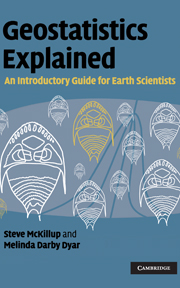Book contents
- Frontmatter
- Contents
- Preface
- 1 Introduction
- 2 “Doing science”: hypotheses, experiments and disproof
- 3 Collecting and displaying data
- 4 Introductory concepts of experimental design
- 5 Doing science responsibly and ethically
- 6 Probability helps you make a decision about your results
- 7 Working from samples: data, populations and statistics
- 8 Normal distributions: tests for comparing the means of one and two samples
- 9 Type 1 and Type 2 error, power and sample size
- 10 Single-factor analysis of variance
- 11 Multiple comparisons after ANOVA
- 12 Two-factor analysis of variance
- 13 Important assumptions of analysis of variance, transformations and a test for equality of variances
- 14 Two-factor analysis of variance without replication, and nested analysis of variance
- 15 Relationships between variables: linear correlation and linear regression
- 16 Linear regression
- 17 Non-parametric statistics
- 18 Non-parametric tests for nominal scale data
- 19 Non-parametric tests for ratio, interval or ordinal scale data
- 20 Introductory concepts of multivariate analysis
- 21 Introductory concepts of sequence analysis
- 22 Introductory concepts of spatial analysis
- 23 Choosing a test
- Appendices
- Appendix A Critical values of chi-square, t and F
- Appendix B Answers to questions
- References
- Index
Appendix B - Answers to questions
Published online by Cambridge University Press: 05 June 2012
- Frontmatter
- Contents
- Preface
- 1 Introduction
- 2 “Doing science”: hypotheses, experiments and disproof
- 3 Collecting and displaying data
- 4 Introductory concepts of experimental design
- 5 Doing science responsibly and ethically
- 6 Probability helps you make a decision about your results
- 7 Working from samples: data, populations and statistics
- 8 Normal distributions: tests for comparing the means of one and two samples
- 9 Type 1 and Type 2 error, power and sample size
- 10 Single-factor analysis of variance
- 11 Multiple comparisons after ANOVA
- 12 Two-factor analysis of variance
- 13 Important assumptions of analysis of variance, transformations and a test for equality of variances
- 14 Two-factor analysis of variance without replication, and nested analysis of variance
- 15 Relationships between variables: linear correlation and linear regression
- 16 Linear regression
- 17 Non-parametric statistics
- 18 Non-parametric tests for nominal scale data
- 19 Non-parametric tests for ratio, interval or ordinal scale data
- 20 Introductory concepts of multivariate analysis
- 21 Introductory concepts of sequence analysis
- 22 Introductory concepts of spatial analysis
- 23 Choosing a test
- Appendices
- Appendix A Critical values of chi-square, t and F
- Appendix B Answers to questions
- References
- Index
Summary
2.8 (1) The “hypothetico-deductive” model is that science is done by proposing a hypothesis, which is an idea about a phenomenon or process that may or may not be true. The hypothesis is used to generate predictions that can be tested by doing a mensurative or a manipulative experiment. If the results of the experiment are consistent with the predictions the hypothesis is retained. If they are not (for an experiment that appears to be a good test of the predictions) the hypothesis is rejected. By convention, a hypothesis is stated as two alternatives: the null hypothesis of no effect or no difference, and the alternate hypothesis which states an effect. For example, “Apatite treatment affects the amount of lead leached from soil” is an alternate hypothesis, and the null is “Apatite treatment does not affect the amount of lead leached from soil.” Importantly a hypothesis can never be proven because there is always the possibility that new evidence may be found to disprove it. A “negative” outcome, where the alternate hypothesis is rejected, is still progress in our understanding of the natural world and therefore just as important as a “positive” outcome where the null hypothesis is rejected.
2.8 (2) The value recorded from only one sampling or experimental unit may not be very representative of the remainder of the population.
4.9 (1) An example of confusing a correlation with causality is when two variables are related (that is, they vary together) but neither causes the other to change. For example, as depth in the ocean increases, light intensity decreases and pressure increases, but the decrease in light intensity does not cause the increased pressure or vice versa.
[…]
- Type
- Chapter
- Information
- Geostatistics ExplainedAn Introductory Guide for Earth Scientists, pp. 380 - 388Publisher: Cambridge University PressPrint publication year: 2010



